Create and Convert Leads as Potential Customers
Learning Objectives
After completing this unit, you’ll be able to:
- State how leads fit into the sales process.
- Explain the difference between leads and opportunities.
- Discuss what happens when you convert a lead.
- Describe how to manage leads effectively.
- Create and convert leads.
The Sales Process from Creation to Conversion
Managing sales leads is like cultivating a garden, where every seed represents a chance to nurture, grow, and harvest a strong customer relationship. Just as every seed needs water and care to thrive, every lead requires ongoing communication, follow-up, and trust to nurture them into customers.
Successful growers need a system to sustain their garden, and every company needs a system to find and retain customers to sustain its business. Salesforce provides exactly that kind of system for growing your pipeline, tending to your garden of leads, and ultimately generating more sales.
This module guides you through the sales process by following a lead record from creation to conversion in Salesforce. Discover new ways to find, review, and work with leads and opportunities so that you can close more deals and ensure your most abundant sales harvest yet.
Generate Leads to Track Potential Customers
Before we go any further, let’s clarify what we mean by leads and opportunities, since they represent different stages in the sales process.
What’s a Lead?
In Salesforce, a lead refers to a potential sales prospect, person, or company that expressed interest in a product or service, but hasn’t yet become a customer. Leads are typically individuals or organizations that a sales team identifies as potential opportunities for business.
Leads are typically at the early stage of the sales process, where the focus is on gathering information, assessing interest, and determining if there is potential for a business relationship.
There are several ways to find leads for your business, including:
- References from other customers.
- Contact form submissions on your website.
- Information exchanges with partner companies.
- Advertisements in search results and on social media.
- Direct contact during conferences or trade shows.
Using leads in your sales process allows you to better track, report on, and target marketing campaigns to prospective customers. Leads can also help you concentrate on the potential deals most likely to close. If your company has separate sales teams for prospective customers and existing customers, using leads helps everyone work more efficiently.
Some companies assign leads automatically, based on criteria like geographical location or sales territory. Other companies assign all new leads to a queue. Your Salesforce administrator will set up a lead assignment process that works for your company. A process can look like this:

What’s an Opportunity?
Essentially, leads are early-stage prospects that require further qualification. Once a lead is qualified, it can progress into an opportunity, which is the next stage of the sales process.
An opportunity represents a qualified lead that’s progressed through the initial stages of evaluation and is considered a viable business deal. It’s generally further along in the sales process and includes more detailed information about the potential sale, including the expected revenue, sales stage, close date, and probability of closing.
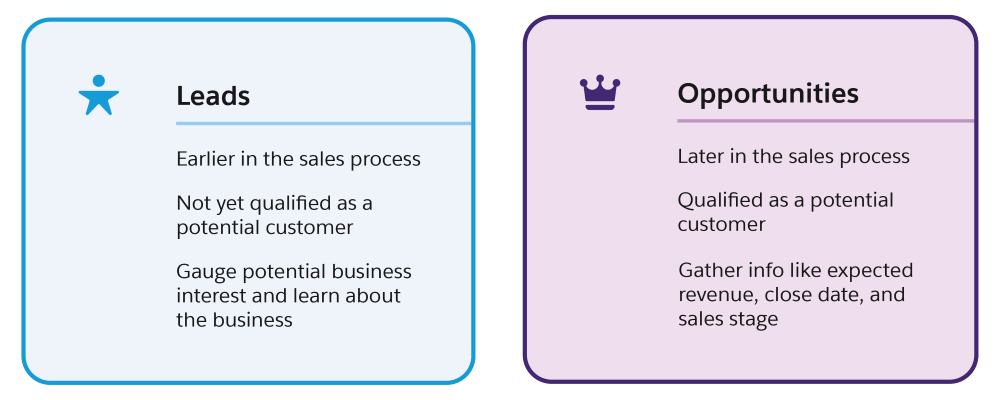
You learn more about opportunities in the next unit.
Manage Leads in Salesforce
Salesforce provides an array of tools that make managing leads a snap.
Understand Lead Records
The lead record is your workspace for tracking interactions, checking campaign history, and planning future activities as you move your lead through the sales process. On your lead record, you may find the following information.
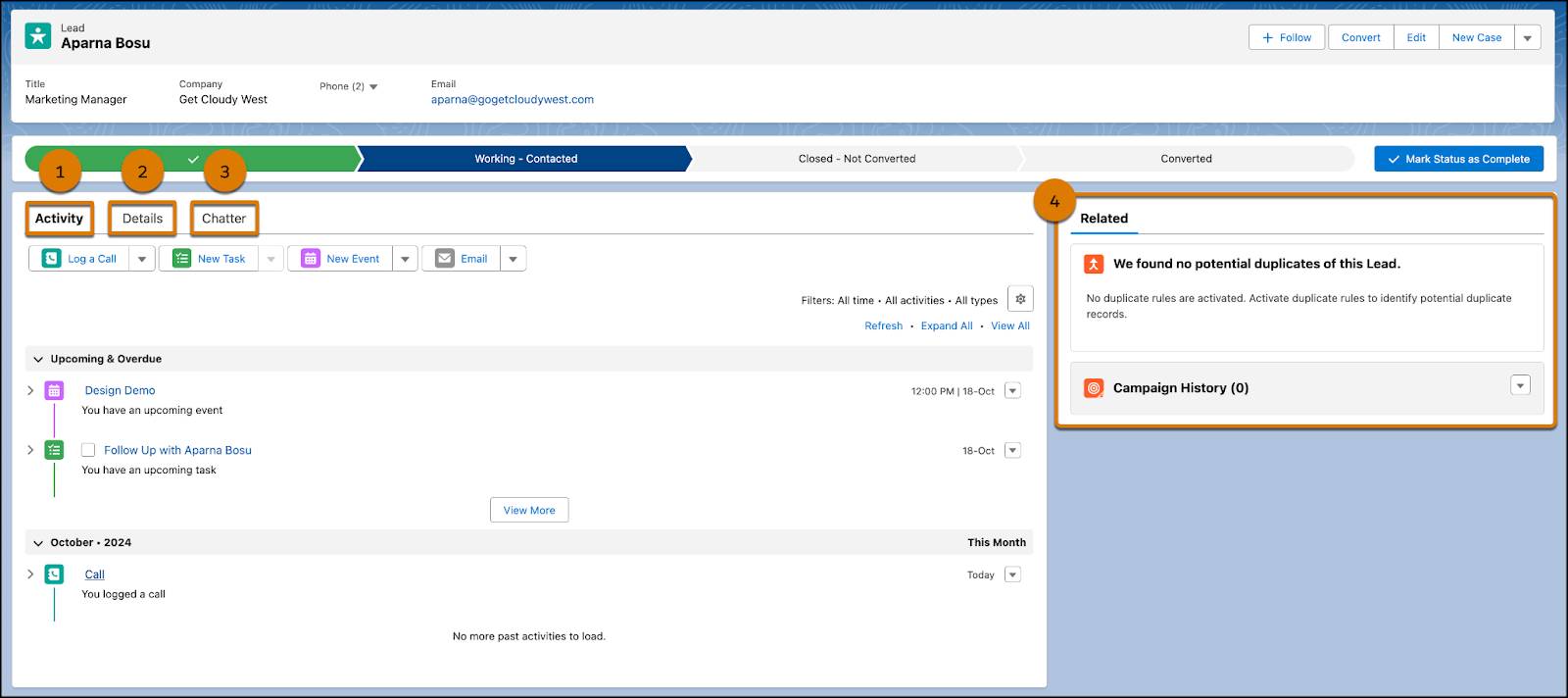
- The Activity tab provides a place to log your calls, emails, and notes from conversations with your lead. Within the Activity tab, you can plan for the future by creating Tasks or Events.
- The Details tab lets you review, find, and quickly update lead information.
- The Chatter tab is where you can collaborate with your team by posting updates, sharing files, and discussing the latest activity around your lead in real time.
- The Related tab displays information such as campaigns or files associated with your lead.
Lead Intelligence View
Lead Intelligence View provides a place to review lead activities, take action, and update records. To open it, navigate to the Lead home page and click Intelligence View. To return to the original view, click List View.

In the Intelligence View, you can quickly filter your leads, review aggregate activity statistics for the resulting records, and take action—all from within the Leads tab.
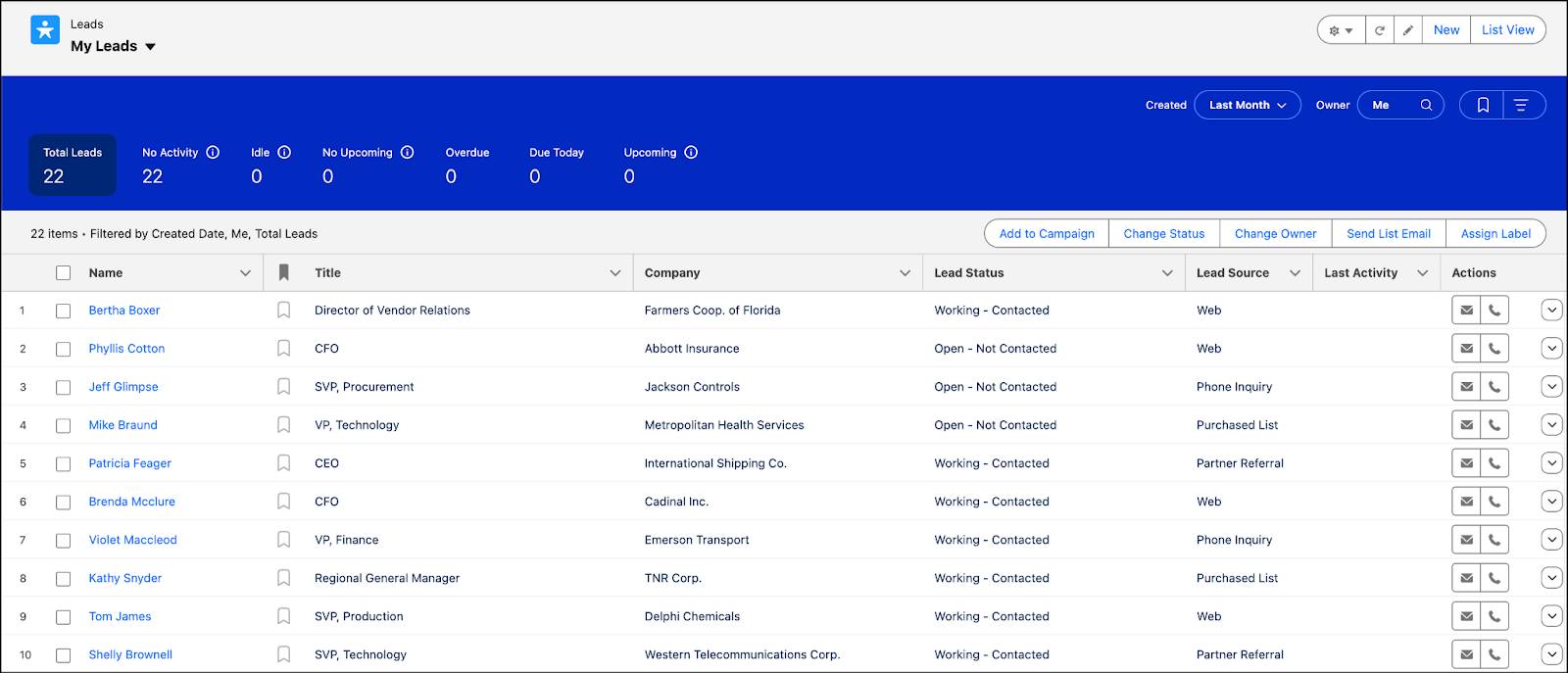
To open detailed activity for individual records, click the side panel icon next to the record name.
Lead activity metrics include:
-
Total leads: The total number of leads that meet your filter criteria.
-
No activity: Leads with no completed activities.
-
Idle: Leads with past activity, but no completed activities in the last 30 days.
-
No upcoming: Leads with recently completed activity but no future activities scheduled.
-
Overdue: Leads with activities that are overdue.
-
Due today: Leads with activities due today.
-
Upcoming: Leads with activities due in the next 30 days.
Sales Engagement
If you work in inside sales, Sales Engagement provides a high-productivity workspace with everything your team needs to handle leads and opportunities more quickly, including:
-
Lightning Sales Console: An intuitive, customizable interface within Salesforce that empowers you with real-time insights, contextual data, and streamlined workflows to accelerate sales cycles and enhance productivity.
-
Work Queue: A dynamic list or dashboard within a CRM system where you can view, prioritize, and manage your tasks, leads, opportunities, or other actionable items based on predefined cadences.
-
Sales Dialer: A tool integrated into CRM systems that automates outbound calling processes for you, enabling you to efficiently connect with leads or prospects, track call outcomes, and streamline follow-up activities to increase productivity and drive sales effectiveness.
-
Cadences: Managers can create custom sales processes that guide you through working with different types of leads.
-
Automation: You can add automations to Sales Engagement to drive productivity. For example, you can automate actions, cadence screen flows, and cadence autolaunched flows.
-
Buyer Assistant: Generate leads, deliver personalized conversations, and close deals faster with a buyer assistant. Buyer Assistant bots transform the web-to-lead experience and help your sales team sell more.
-
Sales Engagement: Understand how the Lightning Sales Console, Work Queue, Sales Dialer, Quick Cadences, Automated Actions, and other Sales Engagement features work together to help accelerate your sales.
Scenario: Generate Leads for Cloud Kicks
You’re a sales rep for Cloud Kicks, a company that specializes in high-end custom sneakers. You recently met a potential lead, Aparna Bosu, at the Cloud Nine trade show. She works at Get Cloudy Consulting and is interested in getting custom shoes for her office’s employees. You get her business card and quickly add her as a lead using the Salesforce mobile app so you can follow up with her after the trade show.

Ready to Get Hands-on with Sales Cloud?
Launch your Trailhead Playground now to follow along and try out the steps in this module. To open your Trailhead Playground, scroll down to the hands-on challenge and click Launch. You also use the playground when it's time to complete the hands-on challenges.
Add Leads to Salesforce
Let’s add Aparna as a lead. Later, you move her through the pipeline.
- Click the App Launcher
 and select Sales.
and select Sales.
- Click the Leads tab.
- Click New.
- Add a lead record for Aparna Bosu.
- First name:
Aparna - Last name:
Bosu - Company:
Get Cloudy West - Title:
Marketing Manager - Email:
aparna@gogetcloudywest.com - Lead Status: Open - Not Contacted
- Enter any other information you have.
- Click Save.
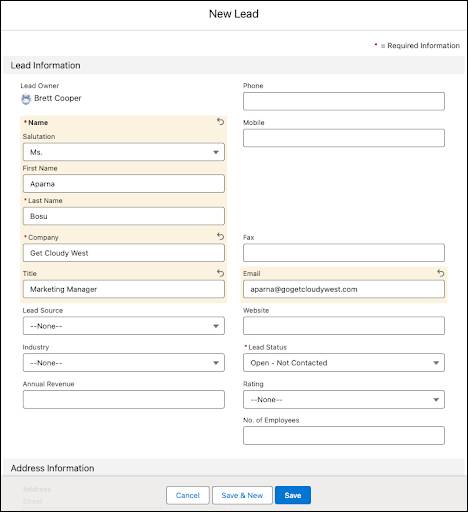
You can also add leads by importing a file into Salesforce or through an automatic process, such as a Web-to-Lead form that collects leads from your business website.
Convert Your New Lead Into an Opportunity
You call Aparna at Get Cloudy West to discuss her deal. She likes what you tell her and seems genuinely interested in buying custom shoes. It’s time to convert her from a lead to an opportunity.
When you convert a lead, Salesforce uses the information stored in the lead record to create a business account, a contact, and an opportunity. If you’ve enabled person accounts and the lead record didn’t include a company name, the lead is converted into a person account and an opportunity.
Let’s convert Aparna Bosu’s lead record.
- On the Leads tab, open Aparna’s lead record.
- Click Convert in the top right.
- In the Account section, create an account from the Company name entered for the lead. If you’re converting a lead who works for an existing account, you select the existing account instead.
- In the Contact section, create a contact from the name entered for the lead. If the contact exists, you select the existing contact instead.
- In the Opportunity section, enter a name for the new opportunity. Give the opportunity a descriptive name. For example, use the account name and a summary of the products they might buy, like “Get Cloudy West - 50 Custom Stratus X11 Sneakers.”
- Check that the Record Owner and Converted Status are correct.
- Click Convert.
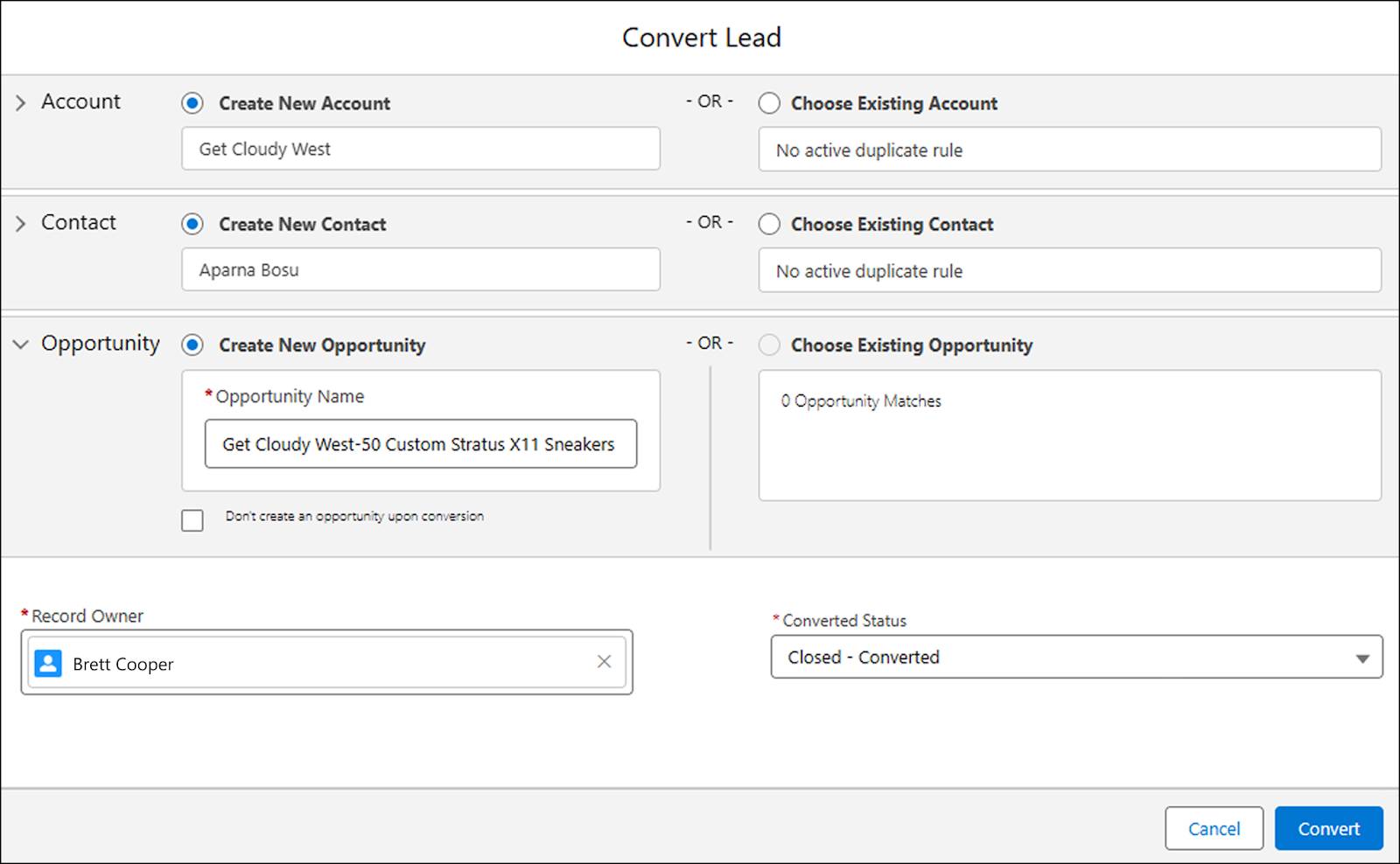
In this case, Aparna indicated she needs 50 pairs of sneakers, and she’s interested in your Stratus X11 model. First, put that information in the opportunity name. Then, use Flow Builder to automate the standardization of opportunity names. If you create an opportunity by converting a lead, Salesforce appends the account name to the new opportunity name automatically. Now that you’ve converted your lead, you’re ready to work on the deal.
Resources
- Salesforce Help: Considerations for Converting Leads
- Salesforce Help: Lead Intelligence View
- Salesforce Help: Things to Know About Merging Duplicate Leads
- Salesforce Help: Sales Engagement